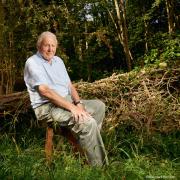On dogs, castles and the importance of titling a piece before you’ve even painted it
Artists’ studios come in many shapes, sizes and locations and Rebecca Day’s is certainly no exception, I reflect, as I sit in the converted granary where she works.
Open plan, with velux windows and a bed for her dog, the door is open on this sunny summer day. Rebecca is a rural illustrator, inspired by her distinctly country childhood, having grown up at Moorden Farm near Penshurst.
Starting out her career in what she describes as a “fairly unappealing” line of work in London, Rebecca missed the countryside and life on the farm. “Kent is wonderful, with London on the doorstep,” she says. “There are little towns, good people and it is the best of both worlds.”
Over the course of our interview, it became clear that Rebecca is closely involved in farm work and adventures, the changing of the seasons and the appearance of wild and farm animals which mainly form her subjects.
While not formally trained in art, she obtained a degree in Countryside Management and worked for a charity giving conservation advice to farmers.
Rebecca had been creating cards while doing this work, so when she was made redundant three years ago it was a relatively short step to develop her hobby and go into art full time.
She holds her own exhibitions because she loves organising events. These can vary from her safe studio to more ‘quirky venues’, as she puts it. One recent exhibition, for instance, took place at Chiddingstone Castle.
“It suits the ethos of my work, and it is good to support venues locally and get visitors into the Castle,” she says.
As for her lack of training, Rebecca remains undaunted, but refers to lessons learned at school which helped her get to know which medium she liked.
“If you have a natural talent, I think it will show through” she says. “This particular genre came naturally to me. I like taking words or titles and thinking about what animal characters would fit into those subjects.
“I paint what is around me - illustration is a more structured way of working. It’s easy to think of a title, like ‘the naughty Labrador and a mouse,’ for instance. I’d get an image and the process flows. Titles are very important, they are the key.
“Often I will think of the title before the actual image itself. Last Christmas, I illustrated according to carol titles. I make a connection between what I see and how that could fit into certain titles”.
Rebecca also had an exhibition centred on childhood rhymes; one was Jabberwocky, another a piece called ‘This is the way the Lady rides.’ Her Gulliver’s Travels depicts a cat walking on a fence.
I asked whether she reads a lot in order to find inspiration. Her answer was quite surprising: “Not really, I love children’s books, old poems, country sayings, and that is where I draw inspiration from.”
Rebecca also does animal commissions and takes them very seriously too. She researches the subject thoroughly, which could mean meeting the subject and getting to know their certain quirks or different mannerisms.
People usually pick up on the humour behind it. Rebecca herself has three ‘naughty’ spaniels and, as she says: “There is always something happening on the farm to catch your eye.”
She believes that imagination counts as the number one skill needed for illustration. “You have to visualise in your head something creative. You need a sense of humour, also knowledge of your subject, how animals move, and so on. For me, understanding the seasons, which plants you’d see together, makes the illustration come to life and people relate to this.”
The works are created in watercolour, but not used in the traditional sense like washes in landscape, plus a pigment ink pen. The process may involve a visit and Rebecca will first of all take photographs. Later she gets involved in more research and does preliminary sketches to get the composition right.
Rebecca also works for rural businesses, so there may be a pre-selected theme for the work. Her biggest paintings are just less than 60cms. Commissions are 43cm by 55cm, framed, on a variety of papers, such as watercolour paper or graphic paper for a logo.
Undoubtedly the most exciting project has been the stationery for her own wedding, which included the invitations and the Save the Date cards.
This has brought her great happiness, but she also says that art is important for bringing happiness to most people. n



























